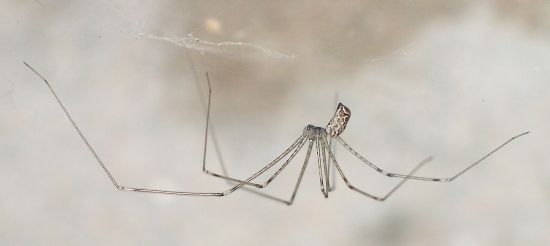by Valerie
May, 2004Marbled Cellar Spider
We have a wide variety of spiders in our yard, most so small that they are difficult to see without magnification. While some roam around looking for prey, others set up their webs in one place and remain for the entire summer. Last year, I noticed a type of long-legged spider in a messy web, the likes of which I had not seen in our yard before. The marbled cellar spider (Holocnemus pluchei) is not native to our area, but after a long search through reference books and the internet, I can only conclude that we have yet another import. Native to the Mediterranean area, the marbled cellar spider is very similar in habits to native species of long-legged cellar spiders, including the common Pholcus phalangiodes. While we don't have a cellar, a sheltered corner of our concrete slab obviously made an adequate substitute. The total size of the spider, including its long legs, was only around an inch. It appeared to hang in midair because the web was just a loose tangle of strands, almost invisible in certain lighting conditions. This group of spiders goes by several different names, including daddy-long-legs spider, long-legged spider, and cellar spider. Although references often cite the confusion between this type of spider and the daddy-long-legs or harvestman (which isn't a spider), the two have very little in common except for long legs. Several types of spiders have a defensive mechanism in which they vibrate their bodies so rapidly that they blur and almost become invisible to their enemies. I've never seen it more pronounced than with the cellar spider. It would hold onto its web with its legs and set up such a wide and fast bouncing motion that it really did practically disappear before my eyes. The camera flash did not bother it, but any disturbance of its web certainly did, and it would go into a long frenzy of this activity. Some species of cellar spiders are known to hunt other spiders. I never saw this one with prey and so don't know its feeding habits, but it survived for the entire summer and didn't look like it was starving. Because these spiders are from warm climates, they more frequently appear inside houses and therefore enjoy a worldwide distribution. One other interesting tidbit I discovered while researching: it has been reported but, as far as I can tell, never substantiated, that the venom of the cellar spiders is the most potent of any arachnid. Because they are so small and their fangs cannot puncture a person's skin, this has never been tested and there has probably never been any research done on the matter. It seems that the tiny cellar spiders have their own amusing urban legend. |